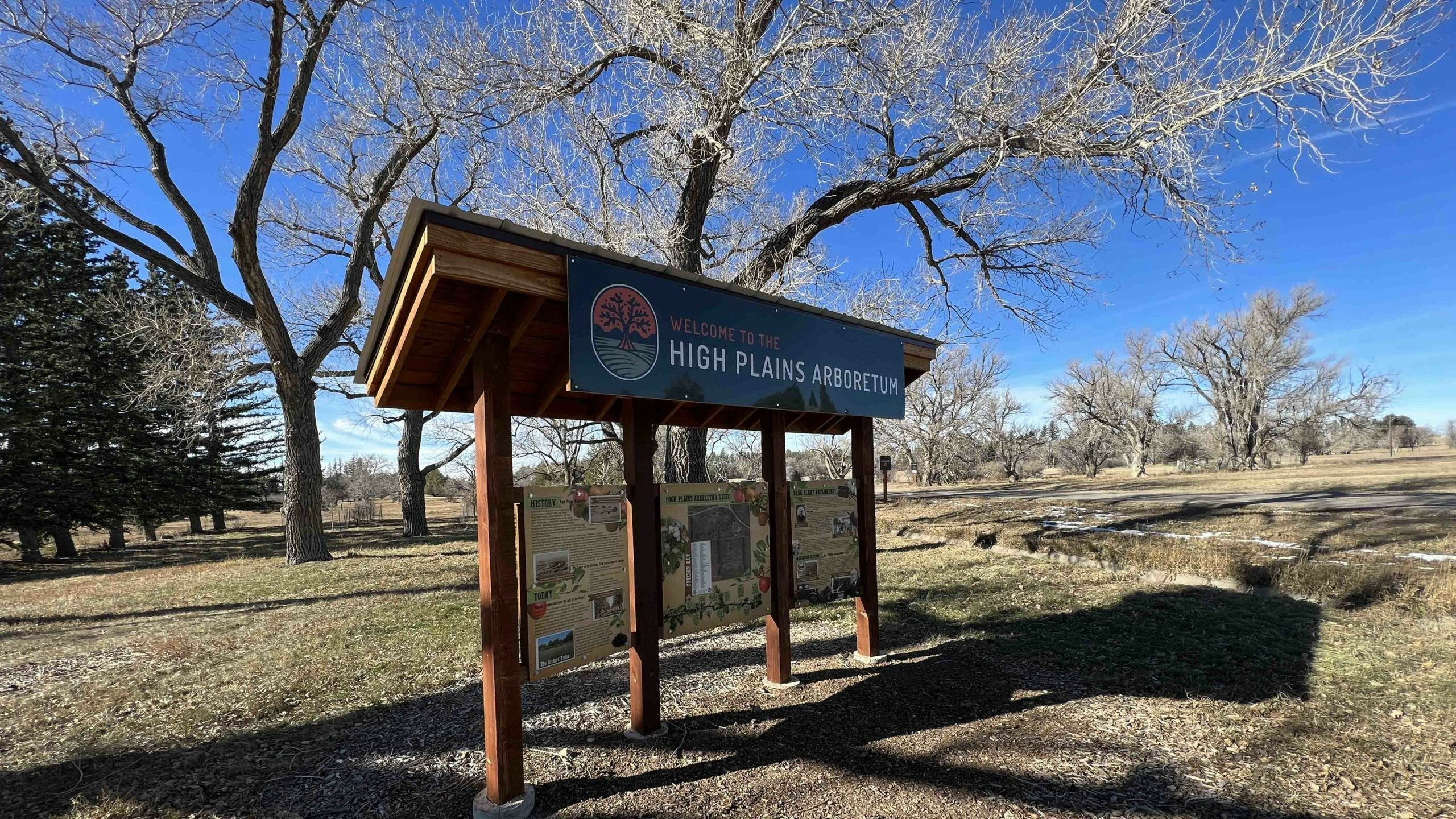By Renée Jean, Business and Tourism Reporter
renee@cowboystatedaily.com
On the northwestern edge of Cheyenne, a piece of the state’s wild history still lives in a hidden gem that’s nearly a century old.
Its history is important not only for the state of Wyoming, but High Plains states stretching from North Dakota to Texas.
The place is the High Plains Arboretum.
Research Mission
Tall, nearly 100-year-old trees still grow there, despite decades of neglect and drought. They are remnants of a unique research mission that began in the 1930s with the construction of a USDA-ARS Field Station in Cheyenne.
It was the first such station that didn’t include as a primary mission agricultural research to improve farming and ranching.
Instead, its mission was to figure out how to help improve quality of life in the High Plains by figuring out which plants could survive the cold, the wind and semi-arid desert-like conditions so that residents from other states would not only feel more at home in the Great Plains, but could grow their own fresh produce.

If It Can Survive Cheyenne …
“You probably can’t go to any High Plains town and not see something that was a result of the work done in Cheyenne,” Cheyenne Botanic Gardens founder Shane Smith told Cowboy State Daily. “And the reason for Cheyenne being more important than the other stations is because they quickly realized that Cheyenne was the worst, most challenging climate of the three (Great Plains) stations.”
A decent variety of strawberry or raspberry or tomato developed at one of the other two research stations would generally get sent to Cheyenne to see how it would do in a really challenging environment.
“Cheyenne became the acid test for plants,” Smith said. “If something came from Cheyenne, they knew it could probably survive from Montana to Amarillo.”


Incredible Diversity
Probably the most famous of trees still growing at Cheyenne’s Arboretum is a willow found near Encampment, horticulturist Jessica Friis told Cowboy State Daily.
“But the oldest tree standing out there is actually a Kentucky coffee tree,” she said. “So that is, you know, a tree that’s native to the United States, but not necessarily Wyoming. It is still alive out there.”
There also are Woodward junipers, originally found in Oklahoma and grown in Cheyenne as an example of an upright, non-spreading juniper tree.
“It gets really tall and skinny and usually keeps a really nice upright form without needing any pruning at all,” Friis said. “So, it’s a nice one for more formal landscapes, if you don’t want to have to prune it.”
There also are apricot trees that came from Siberia and Russia, as well as maples such as the Tartarian maple, the hot wings maple and Amur maple. The latter is hard to find commercially, but is popular because It gets bright red leaves in the fall.
“I’ve actually been propagating that one here at the gardens,” Friis said. “I took some cuttings last year, so I’m hoping in couple of years I’ll be able to sell those at our plant sale. I’ve been propagating (the trees) that we can’t find at a nursery, so that we can make them available in the future.”
There’s also a variety of woody shrubs on the premises, including Cheyenne lilacs and blue velvet honeysuckle.


Indiana Jones Of The Plant World
The wide variety of trees and woody shrubs that call the Arboretum home were the result of an extensive plant explorer network the USDA had both before and after World War II, Smith said.
“These plant explorers were like the Indiana Jones of horticulture,” he added. “They would go to war zones, dodging bullets, some of their Sherpas — people that helped I call them Sherpas, people who helped them haul stuff — and their donkeys got shot in the crossfire.”
Plant explorers rode trains across places like Mongolia and Siberia — places that look a lot like the High Plains — and then would get off the trains at farmers markets and following them north, looking for interesting fruits and vegetables.
They would keep going north until they saw that a variety had disappeared. Then they’d go back one farmers market to the south and take seeds and cuttings to select what they hoped would be the hardiest of plants.
Once they got back to the states, they would do their own research, but also would send plant materials to research stations.
“Cheyenne became a recipient of all kinds of possible apple varieties, apricots, peaches, cottonwoods, shelter belt ideas — they would send all this stuff back,” Smith said.
Researchers would take what seemed to be promising varieties and grow bunches of that plant, selecting out the ones that did the best and then repeating the experiment year over year to develop hardy, drought-tolerant varieties for the Plains.

Thousands Of New Varieties
Over the years that the area served as a horticulture research station, more than 2,000 fruit varieties, 1,300 varieties of woody ornamental plants, 200 species trees and shrubs, and 8,000 vegetable varieties were tested at the station.
Through that work, more than 45 hardy chrysanthemums were developed that would flower much earlier than October, along with all the intriguing trees. Hardy currants, gooseberries, sour cherries, domestic plums and even short-season pumpkins suitable for pie were developed.
“You can still find what they did in seed catalogs and nurseries,” Smith said. “A lot of times they have the name Cheyenne, like the Cheyenne privet or the Cheyenne mock orange. Or they have Wyoming names or Indian names. So they had a style to their naming that is appreciated.”
But eventually, USDA-ARS decided to close the horticulture portion of the lab and shift instead to grasslands research.
“So another unintended experiment ensued,” Smith said. “Especially as we started seeing drought in the ’80s and ’90s. These plants weren’t getting irrigated. And so there was another natural selection of what was out there, and we lost a lot of plants.
“But the ones that remain now, we know that those guys are super drought tolerant.”


Saving The Arboretum
In 2000, Smith and other concerned residents started meeting monthly to talk about how to save the Arboretum where the trees are located. Eventually, that led to an agreement with the USDA releasing between 68 to 75 acres to Cheyenne.
“We got a grant from Wyoming State Forestry to do a master plan of how we’d like to see the Arboretum evolved,” Smith said.
Among the ideas for the future of the station is renovation of the existing greenhouse so that cuttings can be made of the surviving trees, to bring more diversity to the landscapes of Wyoming, and continue some of the research that began at the Cheyenne Research Station.
The location also is open to the public, Friis added.
“We put some new signs out there to help people find it and know where to park and things like that,” she said. “And then we also started last year for the first time a plant sale in February, where people can order trees and shrubs that were tested out at the Cheyenne station.”
Many of these varieties are not readily available commercially, Friis said, adding that “we know they do well in (Wyoming) so people can plant them in their own yard.”
Eventually, the plan is to have an online mode for buying plants from the annual sale. But in the meantime, Friis is willing to help people across Wyoming obtain plants from the sale, if they’re unable to come to Cheyenne in person for the event.
She can be reached at jfriis@cheyennecity.org or 307-287-1953.


New Life For Old Research Station
For the future, Friis sees a lot of tourism potential for the Arboretum, which offers a serene location with beautiful trees and is a favorite spot for a walk in the fall – for those who know about it.
“We’d love to further develop the paths and signs and parking there to make it more accessible,” Friis said. “We’d like to provide public bathrooms out there. We also have the historic greenhouse and lath house building that they used for research. We’d like to restore those and make them available to the public.”
A first priority, though, is new roof for the greenhouses to protect them from further water damage.
“We’re pretty confident we’ll be able to get all of that money ready for this spring or summer to replace that roof so that we don’t get any structural damage to the building,” Friis said.
A second priority is modernizing the available irrigation system, which is gravity-based and actually cannot get water to some trees.
A more efficient watering system also is needed before any new trees can be cost-effectively added to the Arboretum.
After that, Friis hopes to get the greenhouse operational so that cuttings can be made of the surviving trees and shrubs that aren’t available commercially, so that they can become more widely available in Wyoming and other High Plains states.
“If we get the Arboretum up and functioning again, we could definitely start doing some research again, especially as it gets warmer and the climate is changing, now varieties that do well in our climate,” Friis said.
“We’d love to be able to, you know, kind of continue on with this spirit of, you know, it wouldn’t be the same scale as what they did in the Cheyenne Horticultural Field Station’s heyday, but to still continue on with this process of research and searching for new varieties and making them available, and just helping people be able to grow things here.”







